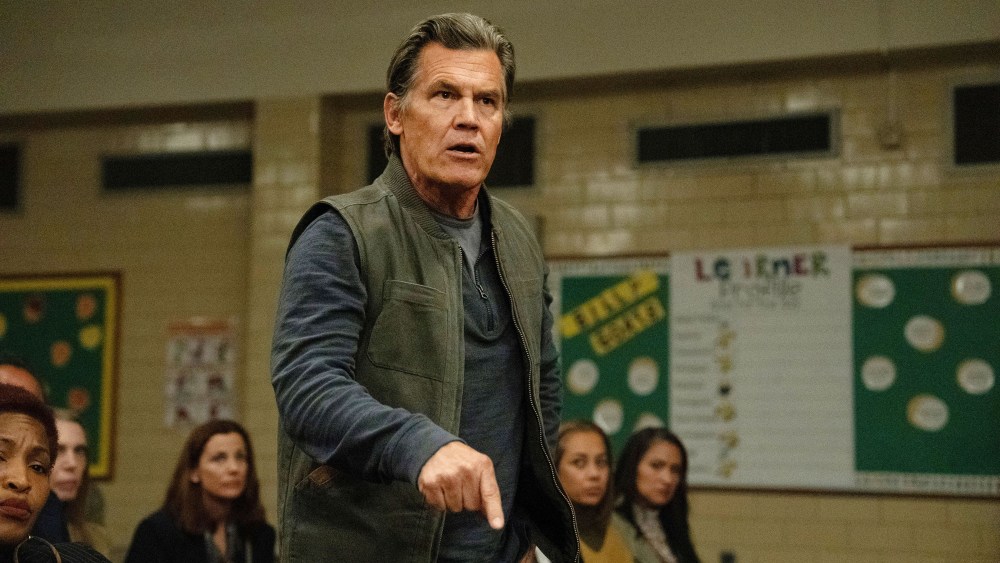SPOILER ALERT: The following review contains mild spoilers.
At 2:17 a.m. on a school night, 17 children go missing all at once. They get up out of bed, open their front doors and run out into the night, arms outstretched, like stealthy little airplanes flying low across the lawns of their sleepy suburban community. The kids have one thing in common: They are all students in Justine Gandy’s third-grade class, which now sits empty, save for a shy boy named Alex, who’s as bewildered as the town’s angry parents that he was spared such a peculiar fate.
It’s an intriguing place to start a horror movie, made all the more unconventional by “Weapons” writer-director Zach Cregger’s choice to let a local girl describe the movie’s ostensibly supernatural premise. Just how much of the shocking and surprisingly gory events that follow could she have been privy to? No matter. As the anonymous young narrator says of her peers’ disappearance, “The police and the top people in this town … were not able to solve it,” a claim that primes us for a mystery that will remain at least partially unexplained — which has lately emerged as a successful horror subgenre, as films like “Hereditary” and “Longlegs” embrace the ambiguity once reserved for oddities like “Picnic at Hanging Rock.”
Significantly expanding the scope and potency of his own sinister powers of suggestion, Cregger comes to this latest nightmare off 2022’s brilliantly deranged “Barbarian,” in which a hellacious vacation rental was but a front, beneath which all kinds of evil had been allowed to fester. The man has a mind uniquely skilled at revealing the threats lurking behind seemingly innocuous environments — in this case, a Pennsylvania town called Maybrook, where the mass disappearance turns mild-mannered parents into an angry mob.
The close-to-home setting and imperfect collection of characters (composed of people whose flaws make them all the more relatable) suggest the best Stephen King movie that Stephen King never wrote. So long as the kids are unaccounted for, our minds are free to make whatever associations might arise. Some may gravitate to QAnon-style conspiracies, whereby murky child predators target the nation’s youth (tonally, the film resembles Denis Villeneuve’s pitch-black “Prisoners”). For me, the community’s reaction suggested the painful aftermath of a school shooting, as parents look for answers, consolation and someone to blame, in roughly that order.
Channeling the hot-tempered sort of guy who surely bullied his peers back in school, Josh Brolin plays a father named Archer Graff, whose son Matt has gone missing. He stands up at a school meeting and implicates Justine (Julia Garner), demanding to know what the teacher did to their kids. That charge hits hard as real-world parents band together to confront school personnel and policies they fear may be brainwashing their kids — one of several resonant phobias vibrating just below the film’s surface, which lend “Weapons” its power.
Instead of picking a single character to follow for the duration of the film, Cregger splinters the mystery among six people, separated into distinct chapters, beginning with Justine. As seen through a glass darkly, each prismatic shard provides fresh insights, as the story rewinds with each new section so key scenes can be replayed from a different person’s perspective: There’s the teacher (Garner), the parent (Brolin), the cop (Alden Ehrenreich), the school administrator (Benedict Wong) and two others whose identities are better left undisclosed.
The pieces fit together like an expertly designed puzzle, eliciting pings of satisfaction as certain details click into place, from the identity of the person who scrawled “WITCH” on Justine’s car to the reason the scuzzy junkie (Austin Abrams) assaulted by law enforcement risks approaching the police station. Through it all, Cregger flashes glimpses of a face in smeared clown-like makeup. In some scenes, this interloper is played by Amy Madigan, all but unrecognizable behind her sloppy lipstick and uneven eyeballs (one is disconcertingly smaller than the other). Like Mary Poppins’ satanic stand-in, Madigan’s Aunt Gladys arrives more than halfway through the film, blending humor and repulsion to create a character distinctive enough to be this Halloween’s hottest costume (cut from the same cloth as Nicolas Cage’s kooky “Longlegs” turn).
For more than an hour, the movie strikes a grimly self-serious tone, reinforced by Larkin Seiple’s steady-handed camerawork and a score that makes your bones vibrate, but once Gladys appears, “Weapons” takes an unexpectedly campy turn. By this point, Cregger has upped the ante, introducing an adult turned homicidal by the same suggestive force that compelled the kids to flee their homes. But as we start to understand why this is all happening, the runaway ideas Cregger’s concept unleashed in our own heads start to narrow to a single, inevitably limiting explanation.
As in “Barbarian,” the violence escalates in the home stretch, during which the title becomes clear and we realize that the community is made up of two kinds of people — targets and weapons — and practically anything, from an impressionable child to a vegetable peeler, can be rendered dangerous in the wrong hands.
For three-quarters of the movie, Cregger’s artfully oblique approach lets our imaginations go wild. It’s only when the answer emerges that “Weapons” starts to lose its edge. Regardless of how you feel about the ending (and many will happily embrace the movie’s darkly comic finale), Cregger has achieved something remarkable here, crafting a cruel and twisted bedtime story of the sort the Brothers Grimm might have spun — not the kid-friendly Disney version, mind you, but the kind where characters kill on command and audiences find it difficult to sleep afterward.

